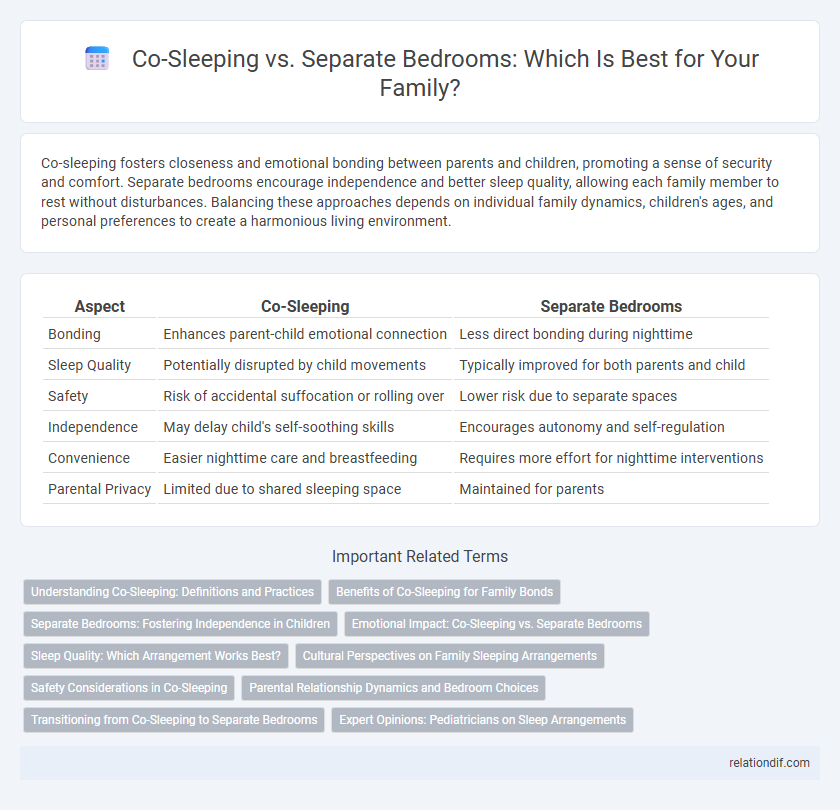Co-sleeping fosters closeness and emotional bonding between parents and children, promoting a sense of security and comfort. Separate bedrooms encourage independence and better sleep quality, allowing each family member to rest without disturbances. Balancing these approaches depends on individual family dynamics, children's ages, and personal preferences to create a harmonious living environment.
Table of Comparison
| Aspect | Co-Sleeping | Separate Bedrooms |
|---|---|---|
| Bonding | Enhances parent-child emotional connection | Less direct bonding during nighttime |
| Sleep Quality | Potentially disrupted by child movements | Typically improved for both parents and child |
| Safety | Risk of accidental suffocation or rolling over | Lower risk due to separate spaces |
| Independence | May delay child's self-soothing skills | Encourages autonomy and self-regulation |
| Convenience | Easier nighttime care and breastfeeding | Requires more effort for nighttime interventions |
| Parental Privacy | Limited due to shared sleeping space | Maintained for parents |
Understanding Co-Sleeping: Definitions and Practices
Co-sleeping refers to parents and children sharing the same sleeping surface or bedroom, a practice deeply rooted in various cultural traditions and family dynamics. Research highlights that co-sleeping can promote bonding, ease nighttime breastfeeding, and improve sleep continuity for infants. However, pediatric guidelines emphasize safe co-sleeping practices to reduce risks such as Sudden Infant Death Syndrome (SIDS), recommending firm mattresses, absence of heavy bedding, and avoiding co-sleeping on sofas or armchairs.
Benefits of Co-Sleeping for Family Bonds
Co-sleeping strengthens family bonds by fostering physical closeness and emotional security, which promotes better communication and trust among family members. Shared sleeping spaces enhance parental responsiveness to children's needs, leading to improved attachment and reduced nighttime anxiety. This practice also encourages synchronized sleep patterns, supporting overall family wellness and connection.
Separate Bedrooms: Fostering Independence in Children
Separate bedrooms encourage children to develop independence by creating a personal space that promotes self-reliance and healthy sleep habits. Studies show that children with their own bedrooms often experience better sleep quality and increased confidence as they navigate bedtime routines independently. Establishing separate sleeping arrangements supports emotional growth and helps children build a sense of privacy and responsibility.
Emotional Impact: Co-Sleeping vs. Separate Bedrooms
Co-sleeping fosters a strong emotional bond, enhancing feelings of security and attachment between parents and children by promoting physical closeness and immediate responsiveness. In contrast, separate bedrooms can encourage independence but may lead to increased nighttime anxiety or feelings of separation for some children. Families often balance these emotional impacts by considering the child's age, temperament, and individual comfort needs to optimize well-being.
Sleep Quality: Which Arrangement Works Best?
Co-sleeping can enhance bonding but often disrupts sleep due to light disturbances and differing sleep schedules, leading to fragmented rest. Separate bedrooms typically promote deeper, uninterrupted sleep by providing a controlled environment tailored to individual preferences and reducing noise and movement disturbances. Studies indicate that optimal sleep quality is more frequently achieved when family members have distinct sleeping spaces, balancing connection with restorative rest.
Cultural Perspectives on Family Sleeping Arrangements
Cultural perspectives on family sleeping arrangements vary widely, influencing co-sleeping practices and the use of separate bedrooms. In many Asian and African societies, co-sleeping is a norm rooted in traditional values emphasizing familial closeness and collective child-rearing. Western cultures often prioritize independent sleeping spaces to promote autonomy and privacy, reflecting broader societal values of individualism.
Safety Considerations in Co-Sleeping
Co-sleeping safety concerns include the risk of sudden infant death syndrome (SIDS), accidental suffocation, and overheating, particularly for infants under one year. Ensuring a firm mattress, avoiding soft bedding or pillows, and keeping the sleep area free from smokers and pets can significantly reduce hazards. Experts recommend that infants sleep in the parents' room but on a separate surface, such as a bassinet, to balance closeness with safety.
Parental Relationship Dynamics and Bedroom Choices
Co-sleeping can influence parental relationship dynamics by enhancing emotional closeness and communication through shared nighttime routines, while separate bedrooms may promote individual sleep quality and personal space that supports autonomy. Couples often choose bedroom arrangements based on factors like sleep preferences, parenting styles, and the need for intimacy or rest, balancing the benefits of proximity against potential disruptions. Research indicates that flexible bedroom choices tailored to family needs contribute to healthier relationships and overall family well-being.
Transitioning from Co-Sleeping to Separate Bedrooms
Transitioning from co-sleeping to separate bedrooms often requires a gradual approach that respects the child's emotional attachment and need for security. Parents can establish consistent bedtime routines and introduce comforting objects like stuffed animals or nightlights to ease the separation anxiety. Research indicates that maintaining open communication and positive reinforcement during this transition supports healthier sleep patterns and fosters the child's growing independence.
Expert Opinions: Pediatricians on Sleep Arrangements
Pediatricians emphasize that co-sleeping can promote bonding and ease nighttime feeding but may increase risks of sudden infant death syndrome (SIDS) if safety precautions are not met. Experts widely recommend separate bedrooms for infants after six months to encourage independent sleep habits and reduce potential hazards. Sleep arrangements should always prioritize the child's safety and developmental needs according to pediatric guidelines.
co-sleeping vs separate bedrooms Infographic

 relationdif.com
relationdif.com